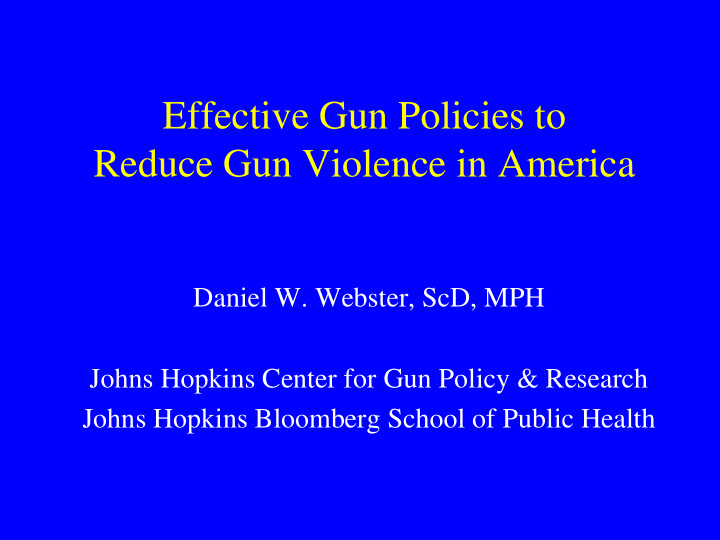



Effective Gun Policies to Reduce Gun Violence in America Daniel W. Webster, ScD, MPH Johns Hopkins Center for Gun Policy & Research Johns Hopkins Bloomberg School of Public Health
Gun Violence in the U.S. in 2010 • More than 31,000 deaths – 19,399 suicides – 11,078 homicides • 338,000 nonfatal crimes • 73,505 patients treated for gunshot wounds in hospitals • Estimated social costs - $174 billion
Firearm-Related Mortality in U.S. by Victim’s Sex, 2010
Gun Ownership and Mortality Risks • State-level studies: After controlling for other risk factors, gun ownership is positively associated with homicide, suicide, and unintentional shooting deaths. Elevated risks greatest for females (Miller, Azrael, Hemenway, 2013) • Case-control studies: Households with guns have higher rates of homicide and suicide after controlling for other risk factors. Elevated risks greater for women than men (Kellermann et al., 1992, 1993; Wiebe 2003) .
Firearms and Intimate Partner Violence in the U.S. • Most women murdered by intimate partners are murdered with firearms. • Virtually all of 2.7-fold increase in homicide risk in the home associated with gun ownership is due to family violence (Kellermann et al., 1993) . • 11-city case-control study: Auser gun ownership increased risk of femicide by intimate partners 5- fold after controlling for other factors. No factor increased lethality risks more ( Campbell et al., 2003) .
Exclusion Criteria for Firearm Possession by Federal Law • < 18 years old (handguns). < 21 to buy handgun from licensed dealer. • Convicted of crime punishable by > 1 year imprisonment • Fugitive from justice • Convicted of domestic assault or subject of final restraining order for domestic violence (if ever married or lived with victim)
Exclusion Criteria for Firearm Possession by Federal Law • Use or addicted to controlled substance • Adjudicated “mental defective” or committed to mental institution. • Dishonorable discharged from military. • Alien, illegal immigrant, persons who renounced citizenship.
Additional Exclusion Criteria in Some States • < 21 years-old • “Convicted” of serious crimes as juvenile • Convicted of misdemeanors involving violence and/or guns. • Broader restrictions for those under domestic violence restraining orders – temporary orders and non-cohabitating intimate partners. • Multiple convictions for drug or alcohol crimes indicative of substance abuse.
Legal gun ownership status of persons before they committed a gun crime leading to incarceration in 13 states with weakest standards for legal gun possession. Vittes et al., 2012.
Percentage of gun offenders who were legal gun possessors in 13 states with weakest standards and the conditions which would have prohibited their gun ownership in states with strict standards for legal gun possession. Vittes et al., 2012.
Age-Specific Homicide Offending Rates 18.0 16.0 14.0 12.0 Rate per 100,000 10.0 8.0 6.0 4.0 2.0 0.0 15 16 17 18 19 20 21 22 23 24 25 26 27 28 29 30 31 32 33 34 35 36 37 38 39 40 41 42 43 44 45 46 47 48 49 <15 50+ Age of offender (years)
Beer vs. Guns: Which is more dangerous in the hands of 18-20 year-olds? • 21 is minimum legal age for alcohol consumption in all 50 states and DC. • Only 12 states and DC set 21 as minimum legal age for handgun possession.
Evidence that firearm prohibitions for high-risk groups reduce violence • Domestic violence restraining order prohibitions linked to intimate partner homicide reductions of 6% to 19% (Vigdor & Mercy, 2006; Zeoli & Webster, 2010) . • Violent misdemeanants’ gun prohibitions in CA lowered risk for commission of violent crimes 29% among denied group (Wintemute et al., 2001) • Greater reduction in violent crime offending by those disqualified due to mental illness alone after NICS reporting than comparison. (Swanson et al., 2013)
Associations between state gun sales regulations and intrastate diversion in 53 cities Webster, Vernick, & Bulzacchelli, 2009 Accountability measure % difference Strong gun dealer regulations + regular audit inspections -68% Private firearm sales regulated -48% Discretionary permit to purchase -64%
State handgun laws association with per capita export of crime guns (Webster et al., 2013) State gun sales laws Effect on export rate Signif. Discretionary permit to purchase -74% .001 Non-discretionary permit to purchase -55% .02 with fingerprinting Background checks for private sales -30% .03 Mandatory theft/loss reporting by owners -29% .02 Junk gun bans -30% .04
Changes in Handgun Sales Regulation in Missouri after Permit-to-Purchase Law was Repealed after 8/28/07 • Private handgun sales no longer require background checks or record-keeping. • Applications to purchase handguns no longer involve trip to local sheriff’s office for fingerprinting. Just apply before the dealer who stands to profit from the sale.
Changes in crime gun source state and diversion indicator after retail sale following the repeal of Missouri’s handgun sales permit law. Outcome measure Change % of crime guns sold < 1 year or < 2 doubled years before crime involvement Crime guns sold by Missouri dealers Rose 57% to 70% Gun homicide rates +25% in MO -10% in U.S.
Gun homicide rates 1999-2010 Missouri, U.S., Midwest
Effects of Youth-Focused Firearm Laws on Suicides Webster et al. 2004 • Child access prevention laws associated with 8% reduction in suicides by age 14-17. • Effects specific to suicide by guns. • No CAP effect on older youth unaffected by law. • Only 18 states have CAP laws.
Conclusions • Many high-risk groups, including IPV offenders, can legally possess and carry guns. • Expanding prohibitions reduce violence. • Weaknesses in US gun policies allow prohibited persons to acquire guns. • Firearm seller accountability policies reduce diversions to criminals and gun violence.
Recommend
More recommend